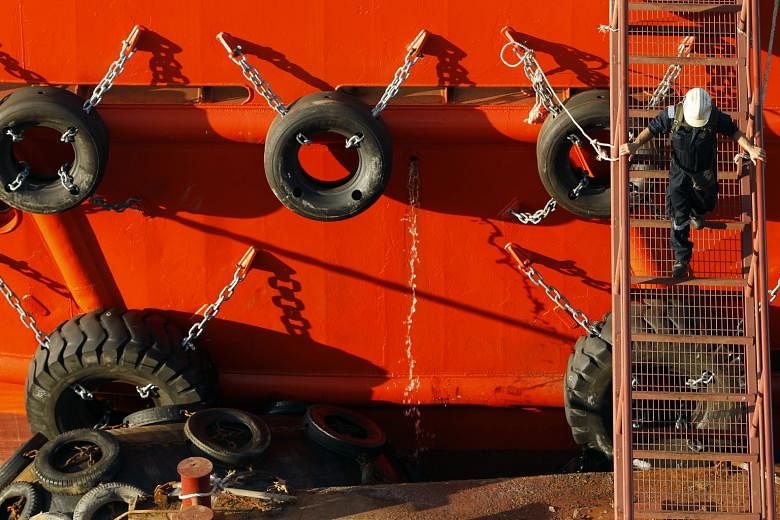Two years after oil prices crashed spectacularly, the full force of the credit crunch finally hit in 2016, sending many in Singapore's offshore oil support industry scrambling to buy time.
Benchmark Brent crude is tipped to stick below US$60 (S$87) a barrel this year, so the bad times may not be over yet.
While owners of offshore support vessels (OSVs) and rigs could see earnings rise to break-even levels from the uptick in oilfield activity as prices stabilise, companies building rigs will remain vulnerable as new orders will not come in as quickly, analysts said.
Singapore's oil and gas sector is dominated by shipyards and OSV owners, where massive excess capacity is an issue.
UOB Kay Hian analyst Foo Zhi Wei said: "OSV and rig fleets are currently operating at a total utilisation rate of 50 to 60 per cent, not counting those vessels and rigs that remain on order."
In fact, on a global scale, rigs on order stand at roughly 20 per cent of total fleet while OSVs on order stand at 6 to 8 per cent of the total fleet, he added.
So even if higher oil prices bump up the number of exploration and production projects that become economically viable and create business for fleet owners, overcapacity in the sub-sector means competition will be fierce.
Service prices - which have fallen by more than 50 per cent from the peak - will not get much of a lift.
The oversupply of rigs also means that builders must wait even longer for an earnings recovery.
"Our view is for 2019 to be the earliest point where orders could start trickling back," said Mr Foo.
"The previous cycle saw a global order drought lasting as long as a decade."
TIME FOR BOTTOM FISHING?
By most measures, the shake-up climaxed last July with the collapse of serial bond issuer Swiber Holdings, which sent tremors through the banking system that had once lent so prodigiously to the oil sector.
Now, investors tracking the beaten-down shares of Singapore's offshore and marine counters have started to question if the worst just might be over - at least from a valuations perspective.
"Current valuations are at 10- to 15-year lows," said KGI Fraser analyst Joel Ng.
This could present an attractive opportunity for those with a one- to three-year investment horizon.
In the nearer term, the market still has another hurdle to clear.
Companies report fourth-quarter financial results from January to February, which "may bring negative surprises such as bigger-than-expected write-downs", said Mr Ng.
According to one industry source, many companies have yet to make provision for their fleets, despite values falling by as much as 50 per cent.
So how friendly auditors will be this time round remains to be seen.
However, CIMB Research said in a note that the size of impairments this round is likely to be lower than in the same period a year ago. After all, impairments in the fourth quarter of 2015 were recognised when crude oil prices had plunged to US$28 a barrel in February last year.
Overall, at least $4.2 billion worth of impairments have been recognised by offshore and marine players here in the past two years, the report also said.
THREAT OF MORE FAILURES
Refinancing also remains a big risk for many highly leveraged offshore and marine players, with some firms still stuck in precarious financial positions that could see them run out of cash even before oil prices stabilise.
Maybank Kim Eng said in a note: "We do not rule out more failures of weak players as banks turn more stringent in granting new and even extending existing credit... players that cannot generate self-sustaining cash flows face the risk of going down like Swiber and Swissco."
In fact, oil and gas issuers could be locked out from the Singdollar bond market for a long time, said analysts. Three bond defaults and a spate of consent solicitation exercises last year made clear to bond holders that they are the lenders of last resort with almost no bargaining power when companies run into trouble.
Retail investors tend to have long memories of soured investments and it could take years before confidence returns to the market.
The firms most at risk of failure this year will be those with high gearing levels of more than 100 per cent, low cash balances and weak operating cash flows, analysts said.
Auditors have cast doubts on some companies' abilities to continue as going concerns.
Ezra Holdings, which does OSV chartering, offshore fabrication and subsea work, sank to a net loss in the 12 months to Aug 31.
Auditors flagged that it would be faced with a going-concern issue if discussions with various stakeholders and consolidation of its funding requirements do not reach a timely outcome.
Ezra has already won investor approval to waive any breaches or potential breaches of both covenants and defaults on $150 million worth of notes due next year.
But OCBC credit analyst Nick Wong called the situation "precarious", as delays in the settlement of a share sale agreement between Ezra unit Emas Offshore and associate Perisai Petroleum Teknologi have thrown a spanner in the works of the group's refinancing efforts.
He said in a note: "The longer Ezra is prevented from resolving the issues at the Emas level, the harder it is for Ezra to access the additional working capital needed to continue work."
Marco Polo Marine, the OSV charterer and shipyard that reported a net loss for the year ended Sept 30, has got investor backing to defer payment on $50 million worth of notes due last October to 2019.
But Marco Polo still had net current liabilities of $26 million at the end of September. Whether it can continue as a going concern will depend on the successful negotiation and restructuring of its bank loans or the generation of sufficient cash flows, its auditors said.
KS Energy, the drilling and rig management firm that saw losses widen last year, had current liabilities exceeding current assets by $251 million as at Sept 30, and $256 million of debt repayable in one year or less.
Meanwhile, other firms are still trying to stretch out their debt payments.
Shipbuilder and vessel charterer ASL Marine is seeking investor approval to loosen covenants on $100 million worth of bonds that would have come due in March, and another $50 million worth due next year.
Shipbuilder Nam Cheong has $90 million worth of bonds maturing on Aug 28, and Falcon Energy has $50 million worth maturing on Sept 19. OSV and subsea services company Pacific Radiance has $100 million worth of bonds maturing on Aug 29 next year.
Nam Cheong and Pacific Radiance are two issuers that are "highly likely" to engage note holders this year, CIMB Research said in a note.
It noted that as at Sept 30, Nam Cheong had negative operating cash flow of $90 million due to a lack of sales.
"The company's order book currently stands at RM1.1 billion (S$355 million), mainly comprising nine vessels for delivery in 2017 and another five vessels in 2018. Assuming no sales in the first half of 2017, we believe there is a high chance Nam Cheong may have to engage its note holders," said CIMB.
While the last of the bond restructuring exercises may not be over, not every issuer took that route last year.
One exception was engineering and fabrication firm Dyna-Mac Holdings, which has maintained a strong cash balance and was the only issuer in the sector to redeem its bonds - $50 million in full - prior to maturity.
Vallianz Holdings, the OSV provider and Swiber associate, also fully repaid $60 million worth of bonds that came due last November, using funds from major shareholder Rawabi Holding.
But it still had US$145 million in debt as at Sept 30, and claims from Swiber's judicial managers have yet to be resolved.
Keppel Corp and Sembcorp Marine have stronger financial backing than the smaller players but analysts have not ruled out more cost-cutting measures from them this year.
THE UPSIDE
The Government has extended a lifeline to marine and offshore engineering firms here, saying at the end of November that it would take on 70 per cent of the default risk for loans made to such companies under certain schemes.
How useful this effort is will depend on the risk appetite of the lending banks. But more help could be on the way, said OCBC Investment Research analyst Low Pei Han: "There are expectations that more measures (lower rent for JTC facilities, relief from foreign worker levy) would be announced in the Budget in February."
Other sources of funding could yet come through. Some funds have told The Straits Times that they are now angling to do convertible issues with some firms - to swap debt for future ownership - while share prices are low.
The question of when lenders will finance oil and gas players again is also tied to the rate at which oil prices recover, Ms Low said.
"If the oil price recovers faster than expected and oil companies gain more confidence and award more projects, then the whole market will benefit and there could be a thawing in refinancing conditions."
Brent crude has been drifting upwards over the past 12 months to trade at US$56.82 a barrel last Friday.
When members of the Organisation of the Petroleum Exporting Countries (Opec) agreed on Nov 30 to cut output by 1.2 million barrels a day for six months starting on Jan 1 - the first supply cut in eight years, oil prices shot up.
On Dec 10, when 11 other non-members of Opec, including Russia, pledged that they too would cut output by 558,000 barrels a day, prices ran up again.
These nations may cheat on production quotas, as they have done before.
But even if this deal had not been cut, oil markets were already expected to balance out in the second half of this year, said KGI Fraser's Mr Ng.


